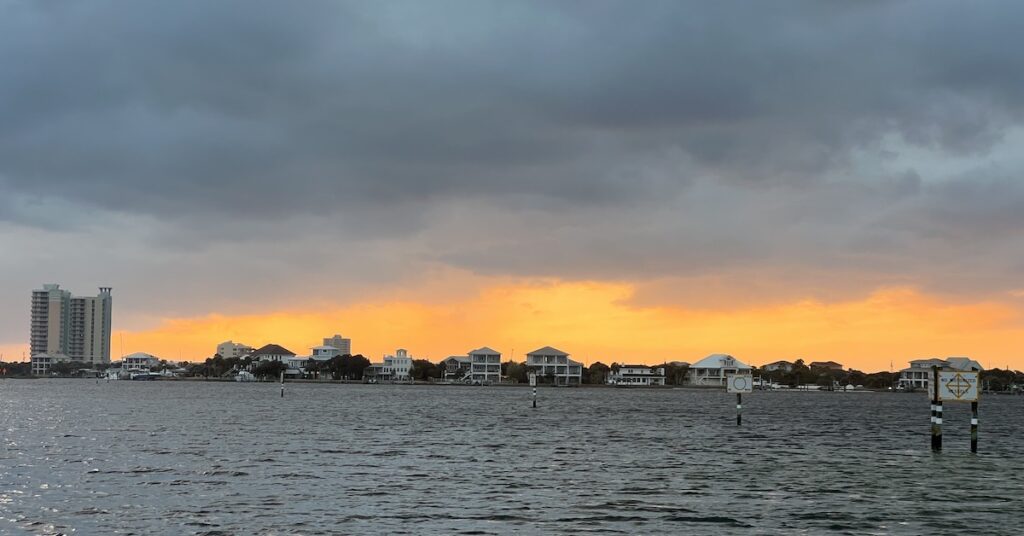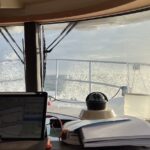December 28: I leave The Wharf Marina and head east to my first solo anchorage.
(continued from At the Wharf)
When Wednesday rolled around, I was past ready to go. I find myself getting antsy when I’m at any stop for more than two to three days, so seven days was killer for me. The cold weather had passed and it was warming up nicely. Not quite warm enough to drive from the command bridge, but warm enough to start enjoying the weather I’d come south for.
I’d been wanting to anchor out more and picked an anchorage that was supposed to be sheltered and easy. It even had close shore access; I could drop the dinghy and row my pups to shore. It sounded perfect — and it was less than 30 miles away.
I packed up what still needed packing, secured everything on board, said goodbye to my neighbors, and headed out at 10:30 AM.

I shot this photo of the east end of The Wharf Marina as I departed eastbound that morning.
The Cruise
Although I don’t remember the wind being an issue that morning, it definitely became an issue later in the day. My notes mention a light chop in Wolf Bay, which is the first small bay I came to about a half hour after leaving the marina. On these otherwise sheltered waterways, waves are usually caused by wind and the farther the wind travels across water, the bigger the waves are. Wolf Bay was a relatively small body of water — especially compared to some of the huge ones I’d be crossing in just a few weeks — so I wouldn’t expect more than a light chop.
The Gulf ICW cut a straight line through the bay and then started making turns as it continued east through other bays. The channel was well marked with red and green markers: red on port and green on starboard — exactly the opposite of what it was when going into a marina.
At around 12:30, I passed a sailboat anchored in the channel right around green marker #61, just before entering Perdido Bay. The folks on board were having engine trouble and while they worked on that, they’d just dropped an anchor to prevent drifting. The only problem with that was that the area still had tows coming through — tugboats pushing barges — and there was one just a few miles behind me that I’d passed earlier. I got on the radio and offered to assist them, although I’m not sure what I would have done. Still, when you see someone out there in a bad situation, you really do need to offer help. They waved me off and I kept going. A while later, I heard them talking to the tow captain and then the coast guard.
Later, I passed a dredging operation right near Robertson Island, where there are white sand beaches. There’s an anchorage there and I think that two of the boats I’d passed earlier in the day wound up there. I’m not sure if it would have been any better than where I stopped. It was just before the inlet from the Gulf at the Gulf Islands National Seashore.

When I look at this photo of the dredging operation I passed, all I can think about is how flat it was there.
Passing that inlet really rocked the boat. Ocean swells came in from the south. They must have been at least two feet from peak to trough and they were widely spaced. I was driving at a pretty slow speed and it seemed to take forever to get past it. Then I was beyond the inlet, cruising along the north shore of Santa Rosa Island in a heavy chop that just didn’t let up.
The wind was from the northeast and that really put the kibash on my backup overnight anchorage, which was on the other side of the causeway from where I planned to park. That anchorage, which was close to a free dock that I may have been able to overnight at, was completely exposed and I’d be rocking and rolling all night. No thanks.
Anchoring at Little Sabine Bay
It was about 2 PM when I made the turn off the Gulf ICW and into the narrow channel that led to Little Sabine Bay. The bay was small with deep water around its edges and shallow water in the middle. There were two marinas in there and I admit that I’d later regret not booking a slip at one of them. Instead, I glided past in remarkably smooth water while the wind pushed the boat forward.

In hindsight, I should have tried to book a slip at one of the marinas I passed as I came into the bay.
The anchor icon on my charts was too close — in my opinion, anyway — to more boats docked along the shore. Beyond that was the sandy beach I’d noted as a place to walk my pups; a small sailboat had parked, nose in, right on the sand. I needed to get beyond him, so I went a little farther.

My approach and final anchoring position in Little Sabine Bay.
Now came the tricky part. I could drop anchor from the bow or from the helm. If I dropped it from the bow, I should be able to get an idea of when the anchor hit and would definitely see how much rode I was playing out based on the markers every 25 feet. If I dropped it from the helm, I wouldn’t see much, but I’d be able to move the boat if it started drifting into shallow water.
I decided on the bow. I pointed the boat into the wind, hurried up to the bow, and pressed the foot button to drop the anchor.
The boat immediately drifted backwards, away from the anchor. We were in 9 feet of water and I played out 50 feet, for a roughly 4:1 scope. (Remember, you need to add the distance from the anchor roller to the surface of the water in the scope calculations. You also need to add the tide difference from high, but there wasn’t much tide and I think it might have been high anyway.)
The wind was howling out there, but the water remained very calm. The description of the anchorage as being “protected” was only partially correct. It was protected from waves but not from wind. Although there were buildings on the shore northeast and east of me, where most of the wind was coming from, the land was flat and there were few trees taller than bushes.
I went inside the boat, knowing that there was no way I’d launch and row a dinghy in this wind. My pups would have to see (and hopefully use) the “pee place” fake grass again.
I set an anchor alarm to see how we were moving. I knew instinctively that a 4:1 scope would not be enough. Over the next hour or so, I kept letting out rode until I had about 100 feet out. That would give us better than 7:1. We seemed to be holding well, but the boat was swinging wildly in a 180° arc.
It would do it all night.

Here’s the Nebo log for the day. Download a PDF log file with more info. Track Do It Now on Nebo.
Settling in for the Night
I got the girls’ pee place out and placed it on the back deck. I encouraged them to use it. They gave me the evil eye. We went back in. I made dinner for myself and ate it. I fed my pups and took them outside again. Nothing.
The sky was thick with clouds, but the sun shone through far in the west, giving a horizon an orange glow long before sunset.
I watched the boat swing in its arc on the anchor line. Even with all that rode out, I wasn’t swinging near enough to either the shore or the shallow area north of me. I wasn’t drifting. I was just swinging.
The wind rattled my mast guy lines and shook my burgees. The rode made creaking and clanking sounds in the roller only a few feet where my head would be when I slept. (Or tried to.)
And this is where I think I screwed up. You see, I had a second anchor and the reason I had the second anchor was to prevent the boat from swinging like this. But I didn’t deploy it. I could have waited until we were lined up with the little channel, dropped that anchor, and tied it with a 2:1 scope to the cleat on my swim platform. If it didn’t stop the swinging completely, it certainly would have put a damper on it.
But I didn’t. Why not?
I think what was going through my mind was that if I had to move the boat in the middle of the night for some reason, it would be easier to move if I only had to pull up one anchor instead of two. That’s the only thing I can think of.
A dumb reason, in hindsight. And one that cost me a decent night’s sleep.


